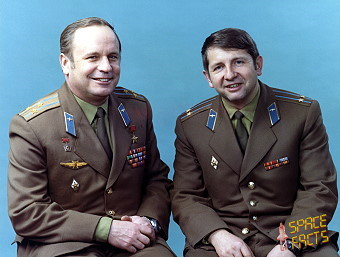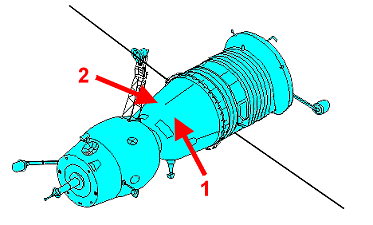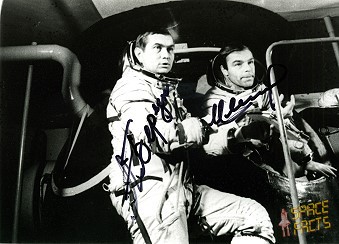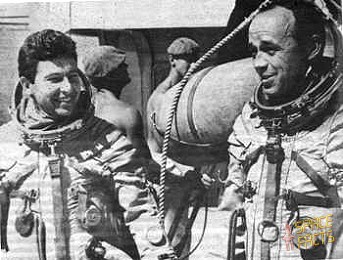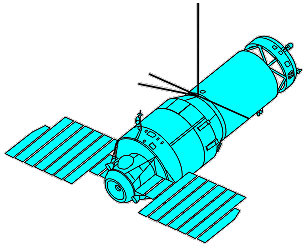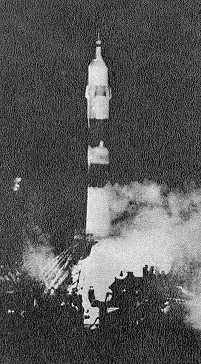Launch from the Baikonur Cosmodrome and
landing 36 km northeast of Arkalyk.
Following a one-day solo flight
Soyuz 24 docked with the space station
Salyut 5 on
February 08, 1977. However, the crew did not immediately enter the station,
atypically having a sleep period first and delaying their entry by some 11
hours. Observers speculate that problems with fumes which may have caused the
Soyuz 21 crew to leave were resolved
or dealt with by the new crew. They entered the station wearing breathing
apparatus and made numerous tests of the atmosphere before apparently
concluding conditions were safe and removing their breathing
devices.
The crew brought repairing tools and equipment for
changing
of cabin atmosphere. This special apparatus was designed to allow the
entire station to be vented through the
EVA
airlock. Because of this the planned
EVA
was cancelled. On February 21, 1977, the crew performed an air-changing
experiment, shown on TV, slowly venting air from one end of the station to the
other while releasing 100 kg of air from tanks in the docked
Soyuz orbital module. This was a test of the future
air replenishment techniques to be carried out with Progress transports in
subsequent space stations. The cabin air was not toxic, so the changing of
cabin atmosphere was performed as a scientific experiment.
The crew
continued the research started by the
Soyuz 21 crew, performed Earth resources work, biological and
materials experiments. But, being a part of the Almaz military
Salyut program, other unrevealed projects were likely
carried out. The flight would prove to be not only the final flight to a
military
Salyut station, but also the final all-military crew
to be launched by the Soviets.
The
Soyuz spacecraft is composed of three elements
attached end-to-end - the Orbital Module, the Descent Module and the
Instrumentation/Propulsion Module. The crew occupied the central element, the
Descent Module. The other two modules are jettisoned prior to re-entry. They
burn up in the atmosphere, so only the Descent Module returned to Earth.
The
deorbit burn lasted 188 seconds. Having shed two-thirds of its mass, the
Soyuz reached Entry Interface - a point 400,000 feet
(121.9 kilometers) above the Earth, where friction due to the thickening
atmosphere began to heat its outer surfaces. With only 23 minutes left before
it lands on the grassy plains of central Asia, attention in the module turned
to slowing its rate of descent.
Eight minutes later, the spacecraft was
streaking through the sky at a rate of 755 feet (230 meters) per second. Before
it touched down, its speed slowed to only 5 feet (1.5 meter) per second, and it
lands at an even lower speed than that. Several onboard features ensure that
the vehicle and crew land safely and in relative comfort.
Four parachutes,
deployed 15 minutes before landing, dramatically slowed the vehicle's rate of
descent. Two pilot parachutes were the first to be released, and a drogue chute
attached to the second one followed immediately after. The drogue, measuring 24
square meters (258 square feet) in area, slowed the rate of descent from 755
feet (230 meters) per second to 262 feet (80 meters) per second.
The main
parachute was the last to emerge. It is the largest chute, with a surface area
of 10,764 square feet (1,000 square meters). Its harnesses shifted the
vehicle's attitude to a 30-degree angle relative to the ground, dissipating
heat, and then shifted it again to a straight vertical descent prior to
landing.
The main chute slowed the
Soyuz to a descent rate of only 24 feet (7.3 meters)
per second, which is still too fast for a comfortable landing. One second
before touchdown, two sets of three small engines on the bottom of the vehicle
fired, slowing the vehicle to soften the landing.
![]()

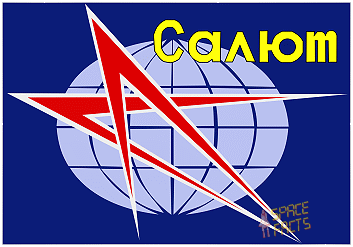
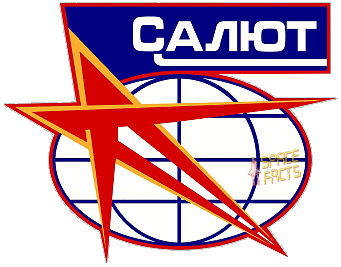
![]()
